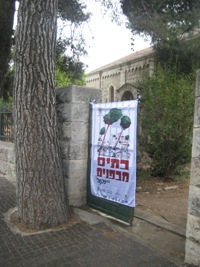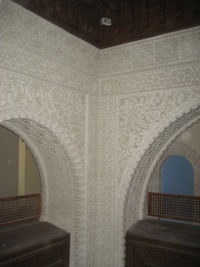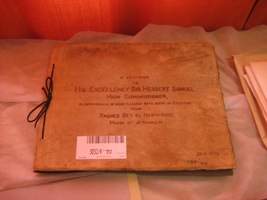At least once a year a fascinating event takes place in Jerusalem. During the festival of Houses from within many private people and various institutions open the gates of their homes and buildings and let every curious visitor inside free of charge. For a whole weekend the city of Jerusalem fills with those of us who love the mysterious and magical corners which are closed to the public most of the year. Many organizations and private people cooperate with the event that is being produced voluntarily by the architect Alon Ben-Nun and Aviva levinson. They are the founders and the dreamers who, with a lot of enthusiasm and love of the profession, succeed every year to open the hearts of even the most stubborn landlords that hold in their possession the keys to secret gardens and unknown courtyards. The owners of the houses that are opened to the public often meet the public during the days of “Houses from within”, answer questions and guide them around the place voluntarily.
This year I was both a guide and a tourist in the events of “Houses from within”. As a tourist I was curious about a few open houses and institutions. I paid my first visit to the World center of the North Africa Jewry. I visited there on a Friday early morning hour. I have not visited there for a few years and rumors of extensive renovations made me wait at the locked gate for a quarter of an hour. Finally, right on time, came a man named Albert Gozlan to the gate. He is one of the leaders of the Moroccan community in Israel. As he opened the gate for the many curious visitors we found ourselves in the middle of a construction site. It was obvious there was still a lot of work to be done here (The Moroccan artists left for a while because of the Ramadan period, said Gozlan). Even the electricity was not working yet. However, even as it was the place was just beautiful. Magnificent mosaics decorate the walls and floors, interesting wooden Moroccan engraving and delicate stone engraving can be seen in every corner. In another room, wrapped and waiting for happy days to come were a few presents that King Hassan the Second of Morocco gave to Shimon Peres. An Andalusian style garden is being built near the front gate. No doubt, when the work is finished we shall have another wonderful site we can add to our tours in Jerusalem.
Another place I visited that day was the office of the Israel state archives. You can find the Israel state archive in Makor Haim, the back yard of Talpiyot. Millions of documents, certificates and diplomas are stored on about 40 Kilometers of shelves in a warehouse. In the office building where I visited we could only find the visitors center. Me and the others watched a nice presentation about the archives tasks. There was also a small exhibition of some documents of interest. I was especially enthusiastic about the picture album that was given in 1925 by Ragib Nashashibi, the mayor of Jerusalem to Herbert Samuel, the first British High commissioner in Palestine when he left his position. The album has some wonderful unique photos. I loved the series of pictures taken at the inauguration of King George Street during the year of 1924. I could recognize the yet unfinished street and Jews, Muslims and British people standing side by side smiling as a reminder for long forgotten days.
Apart for these two sites I had only a few minutes to enter the Templers Cemetery in the German colony and old community center in the neighborhood that was converted to an Armenian church long time ago. I also wanted to try and visit “Villa Lea” in Rehavia. This year was the first time the house has opened its gates. The building was built by Nasiv Avkarius Bay, A successful Greek, Christian lawyer, for his wife, Lea Tenenboim (who came from an ultra orthodox Jewish family). Lea left her husband for another, and the poor guy had no other choice but to rent the house. Many people had lived there since, including the exiled Ethiopian emperor Haile Selassie and the chief commander of Jerusalem, Moshe Dayan. These days two Israeli families live in the house and most of the time, prefer to keep their privacy. That day Villa Lea was opened and an unbelievably huge crowd was waiting outside. As I couldn’t get inside “Villa Lea” I decided it was my turn to contribute a little of my knowledge. I arrived in Beit Shmuel, where I lead a few public tours. I showed the visitors Beit Shmuel and the adjacent Shimshon Center. I spoke of the architectural aspects of the place and the cultural events that are happening there. We went up to the roof of the impressive building to see the Blaustein hall, famouse for its glass dome. I think I guided at least 200 people. At the end of the day I thought these numbers were solid proof that “Houses from within” is an important event both for the citizens of the city and for people who love tours in Jerusalem.



